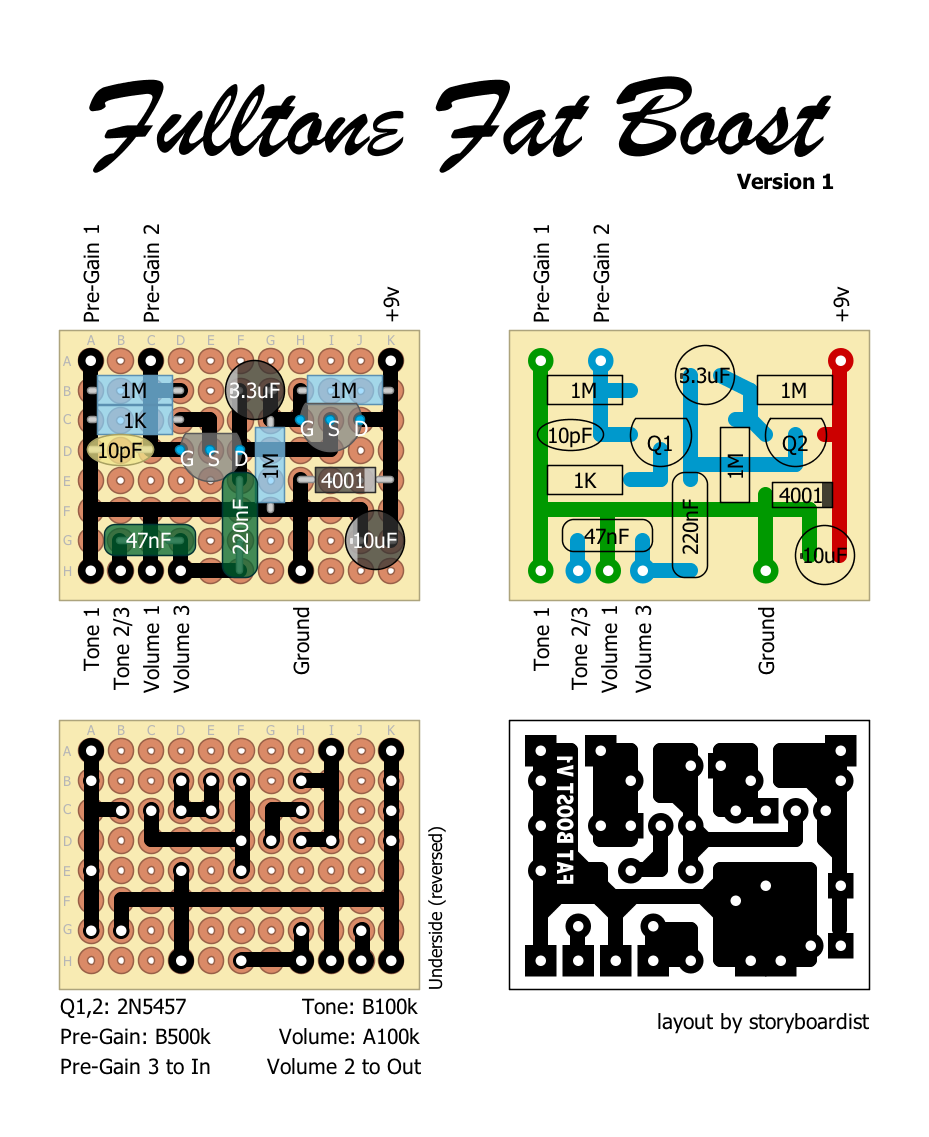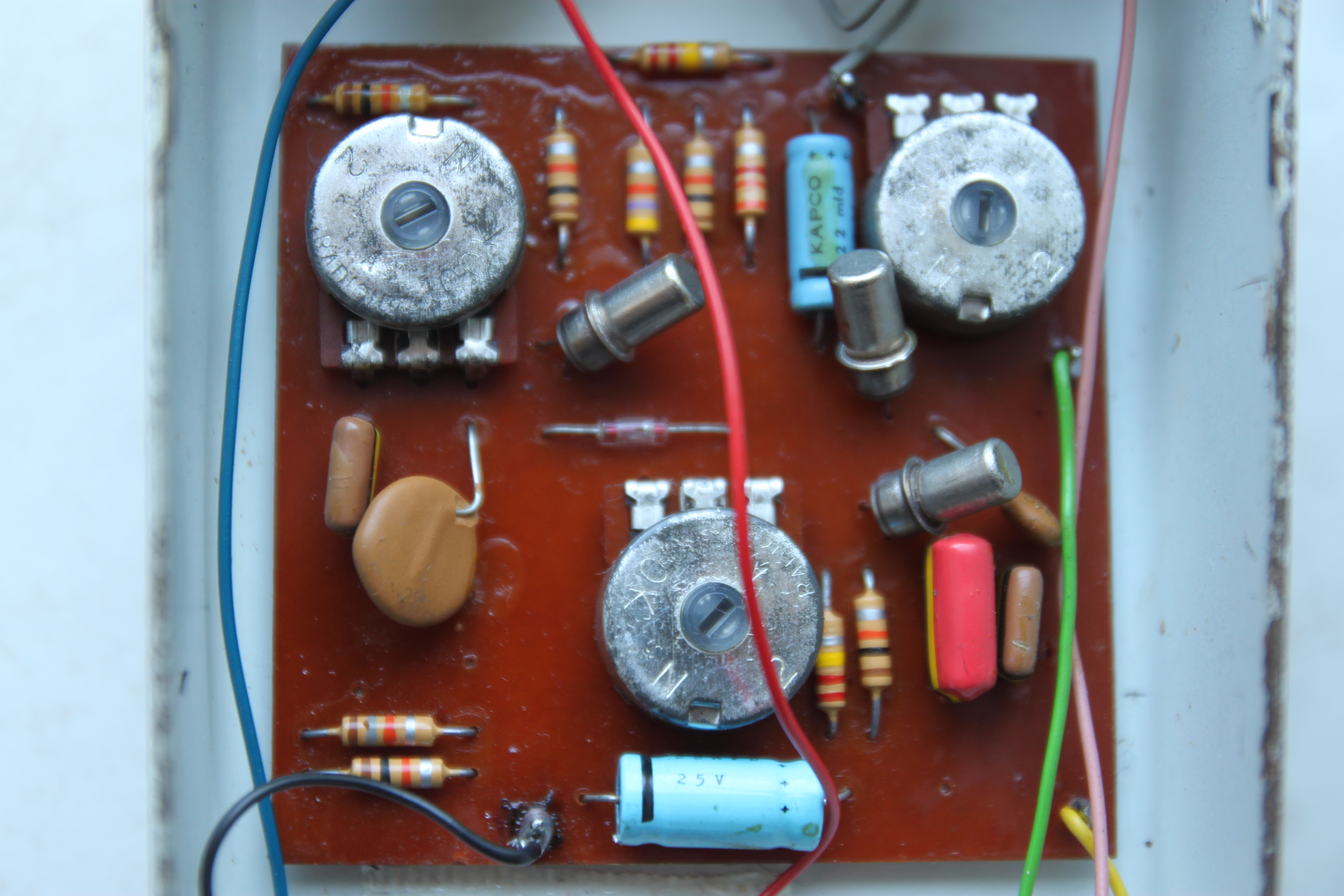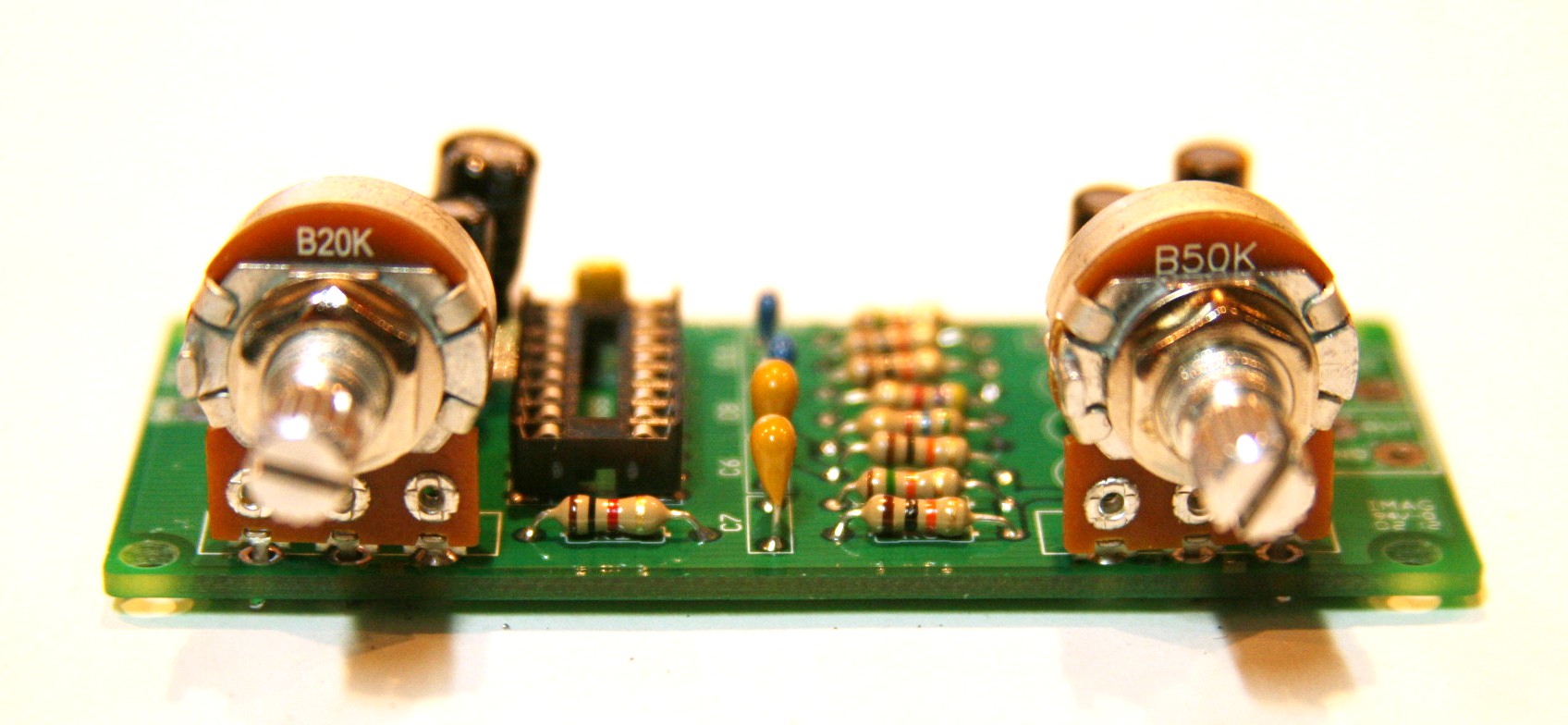This is a library of perfboard and single-sided PCB effect layouts for guitar and bass. I'm not an electrical engineer by any stretch of the imagination, just a DIY'er who likes drawing layouts. It is meant for the hobbyist (so commercial use of any of these layout is not allowed without permission) and as a way to give back to the online DIY community.
Friday, November 28, 2014
Univox SuperFuzz (modded)
Here the Univox SuperFuzz with the mods done by FSB member derringer. It replaces the stock tone switch with a pot, as well as a few other useful mods. Socket the 2 ceramic caps going from the base to collector on Q1 and Q6 and try some different values (I'm guessing in the 100pf to 500pf range). This one's a little on the wide side, so you'd be hard pressed to fit it in a 1590B, but it should fit quite nicely in a 1590BB.
Wednesday, November 26, 2014
Mosrite Fuzzrite
Here another classic fuzz, the Mosrite Fuzzrite. This is the silicon version. The original transistors were marked "TZ82" so be sure to use sockets and try a few different ones out. The original pots were 350k and 33k, which are going to be difficult values to track down. You can either use 500k and 50k, or use 500k and 50k and add fixed resistors in parallel (between lugs 1 and 3) to try and recreate the original values.
Saturday, November 22, 2014
DOD Overdrive 250 Grey Spec
Here's the grey spec DOD Overdrive 250 that fits in a 1590a enclosure. You could also build a yellow spec 250 or the MXR Distortion + with this layout. Just compare the schematics and value swaps.
Friday, November 21, 2014
Crap-Fi Delay
Here's a fairly simple PT2399 delay from Allesz over on FSB. Here's what he had to say about it:
It is a simple circuit and it works good but: the mix and repeats pot are a little interactive in quite a strange way (anyway they work different from a standard echo: to turn off the delay you don'use the mix pot, but you turn to zero the feedback pot) and the on off is a little bit noisy (the clip is recorded at low volume and you will hear kids (always noisy) and clicks so, mostly, the clicks are from the mechanical sound of the switch, but a little noise makes it to the amp too) in order to minimize the clicks the input is grounded on bypass.
The major differences between my schem and the others pt2399 projects I know are that I didn't use the opamp between pins 14 and 13 and I didn't put a cap between pin 2 and three (repeats sounded cleaner to me this way).
I put a small switch to select between long and short delay; the long delays are quite dirty.
It is a simple circuit and it works good but: the mix and repeats pot are a little interactive in quite a strange way (anyway they work different from a standard echo: to turn off the delay you don'use the mix pot, but you turn to zero the feedback pot) and the on off is a little bit noisy (the clip is recorded at low volume and you will hear kids (always noisy) and clicks so, mostly, the clicks are from the mechanical sound of the switch, but a little noise makes it to the amp too) in order to minimize the clicks the input is grounded on bypass.
The major differences between my schem and the others pt2399 projects I know are that I didn't use the opamp between pins 14 and 13 and I didn't put a cap between pin 2 and three (repeats sounded cleaner to me this way).
I put a small switch to select between long and short delay; the long delays are quite dirty.
Thursday, November 20, 2014
Escobedo Octup!
Here's a clean octave up effect from Tim Escobedo. The Bias control offer subtle changes, which is why I have it as an external pot. He mentioned it might need a booster in front of it, just FYI.
Wednesday, November 19, 2014
Fulltone Fat Boost v1
There was some controversy over this pedal from Fulltone as the circuit is practically identical to the Jack Orman Mini-Booster. Fulltone no longer makes this version of the Fat Boost and now makes a 4-control version with an extra FET stage and more EQ controls. Regardless, it's a great pedal for beefing up your tone.
The perf and PCB layouts are slightly different. I was able to give the components more breathing room on the PCB that wouldn't be feasible on perf.
Tuesday, November 18, 2014
Run Off Groove Peppermill
Here's a nice transparent drive from Runoffgroove.com. Not a ton of headroom apparently, but has a nice bluesy tone. In the layout, Q1 is oriented for a 2N7000, so if you use a BS170 be sure to rotate it 180º.
Monday, November 17, 2014
Way Huge Red Llama
The Red Llama by Way Huge is a great tube-like overdrive with plenty of output. I've drawn 3 layouts–one for every typical Hammond box! The 1590A layout uses 9mm pots which you should be able to board-mount. The other 2 use typical 16mm pots. Make sure to use the unbuffered CD4049 or else the circuit won't work.
Saturday, November 15, 2014
SolaSound Tone Bender Mk. III
Smoother sounding than the Mk. II Professional, the Tone Bender Mk. III not only added a tone control, but the circuit was a deviation from earlier Tone Benders. Q1 and 2 create a Darlington pair that amplify the signal, while Q3 is what creates the fuzz. I've laid this out for negative ground operation, so make sure to use NPN transistors. Q1 and 2 can be low gain silicon if you don't want to use germaniums. Q3 could also be silicon, but a germanium is most likely going to sound best. You can also reduce the value of the 220k resistor (or just replace with a jumper) between Tone 2 and Volume 3 for more output.
Here's a compact layout:
Here's a compact layout:
The original TB3 had a cool way of mounting the pots to the circuit board (see pic below). This approach was later emulated by Ross with their Distortion, Compressor, and Phaser pedals, and ProCo with the RAT.
Since I'm a sucker for eliminated offboard wiring, I created another layout (PCB only, sorry) inspired by the original, but updated for more modern components (like radial electrolytic caps and 16mm pots) and to fit in a 1590B or 125B.
And a shot with the components not in "outline" mode.
This has an optional 1M resistor between the base and collector of Q3 if using silicon transistors.
This layout can also be used for the Vox ToneBender Mk. III and the 3-knob Park Fuzz. See Fuzz Central for component changes.
Friday, November 14, 2014
Klon Buffer
Who doesn't love a Klon, right? Here's the buffer stage of the Centaur. The original Klon uses one side of a TL072 for the buffer and the other for gain stage. If you're building the just the buffer, you can get away with a TL071. I've laid out a perf and PCB for each.
Jordan BossTone
Many associate this pedal with the fuzz tone for "Spirit in the Sky" by Prodigal Son, though I'm fairly sure that theory has been debunked. At any rate, it's a great sounding fuzz, and should be a fairly easy build.
Monolith Oracle Fuzz
This is a pretty cool fuzz box. It's a cross (sonically anyway) between an early Vox Tone Bender and a Big Muff. It uses PNP germanium transistors, but still uses a negative ground power supply. Originals have OC76 transistors with hfe of around 100 for Q1 and 300 for Q2. 300 is high for most PNP germ. devices and might be hard to source, but I've read of people using trannies with typical Fuzz Face gains (70, 100) with good results. The switch on the original is a push/pull on the 250k pot, but a DPDT switch can also be used.
Wednesday, November 12, 2014
Trill Tremolo by MOD Kits
Here's another layout for a MOD pedal, the Trill Tremolo. On board pots and LED resistor to reduce the offboard wiring mess. I built this one this past summer and I liked the way it sounds, though the Speed control should probably be a reverse log pot. Haven't had the opportunity to experiment there yet. Here's a demo of the MOD kit:
The layout is verified and here's a few pics from my build.
The Aggressor by MOD Kits
MOD Kits has several cool effects kits that are point-to-point using tag strips. The only downside to those is they can take up a lot of space in an enclosure. Here's one of their newest circuits, The Aggressor. It's a high gain distortion effect. Here's a sound demo from their site.
Tuesday, November 11, 2014
ETI Fuzztone
FSB forum member Nocentelli posted a schematic for this so I thought I'd draw a perf layout for it. Here's what he had to say about it:
"It's a fuzz/distortion/dirt circuit designed by Dan Coggins (Lovetone + Dinosaural designer) for ETI magazine in 1993. Having breadboarded it, I like the sound a lot (like Timmy's vulgar older brother), the tone pot seems to be a nice useful variation of the BMP."
ZVex Fuzz Factory
Here's my take on the ZVex Fuzz Factory. The originals have the pots mounted to the board as well, but ZVex uses the little square pots which are more expensive. I wanted a layout that used regular 16mm pots, which are easier to come by and what you probably already have in your parts stash. Q2-3 originally were AC128s, but any PNP germaniums should work fine. I believe ZVex has used a variety of different germaniums over the years. Hfe ranges should be around 70-100 and 100-150 respectively (much like a Fuzz Face).
For what it's worth, most of my layouts with onboard pots are meant to be mounted from the solder side of the board, like this:
This way, the board will be vertical inside the enclosure, and the controls will be aligned like the original:
Monday, November 10, 2014
Lovepedal Woodrow
This is one of the many variations of the old Electra Distortion. Sounds like a cranked Tweed 5E3 amp. The original Lovepedal Woodrow has just a volume knob, but it's easy (and useful) to add a gain control. If you just want one knob, connect Gain 3 to Gain 2.
Sola Sound Tone Bender Mk. II Professional
Here's another layout with onboard pots. The Sola Sound Tone Bender Mk. II is probably most famous for shaping some (but not all) of the guitar sound of legendary guitarist Jimmy Page on Led Zeppelin I. Originally it was a positive ground effect, but I've laid it out to use NPN transistors. This way you can daisy chain it with normal negative ground effects, or avoid using a 9V battery or making a voltage inverter. I've added a polarity protection diode and a pulldown resistor at the input. I would also recommend as I did with the Fuzz Face, to swap the stock B1k pot controlling attack with either a C1k or B2k pot for better control.
The hfe of the transistors should be around 70 for Q1 and 2, and 100 for Q3 (according to Fuzz Central). I've personally had good luck with some Russian MP38a transistors. You can also build the Marshall Supa Fuzz with this layout by making the following substitutions:
The hfe of the transistors should be around 70 for Q1 and 2, and 100 for Q3 (according to Fuzz Central). I've personally had good luck with some Russian MP38a transistors. You can also build the Marshall Supa Fuzz with this layout by making the following substitutions:
- Increase both 4.7µ capacitors to 10µ
- Reduce the 100k resistor going from the base of Q1 to ground to 10k
- Reduce the 100k resistor going from 9v to the collector of Q2 to 47k
You can also use this layout to make the original positive ground effect using PNP transistor by just inverting any polarized components (basically just flip around the 3 electrolytic caps and diode).
Jordan Vico Vibe Tremolo
Not really a vibrato circuit, but a nice sounding tremolo. This layout is based on the schematic drawn by LucifersTrip on the FSB forum. I've increased the value of the film capacitors from 100n to 220n to reduce the maximum speed a little and make it more usable. People seem to have used anything from 100n to 500n for those caps, so there's room for experimentation there. I also laid it out to utilize onboard pots. It will fit nicely in a 1590B. Just drill the holes for the pots 1.2 inches apart.
The 6V8 diode is a zener, by the way.
Sunday, November 9, 2014
Axial Fuzz
Here's a silicon Tone Bender type fuzz by Nocentelli from FSB. Just about any NPN silicon trannies will do... 2N2222, BC108, 2N3904, etc.
Saturday, November 8, 2014
Maestro MFZ-1 FuzzTone
Not the Maestro stompbox that produced the classic "Satisfaction" tone, but a good sounding fuzz nonetheless. This came out during the Norlin era of Gibson/Maestro in the 70s. The original used a TL022 opamp, but I've listed the TL072 because it's more likely to be in your parts bin. I've also up'ed the power filter cap from 2.2µ (which wouldn't do a lot) to 47µ.
Here's a demo of an original:
Here's a demo of an original:
Friday, November 7, 2014
NPN Fuzz Face
Not that the internet needs another Fuzz Face layout, but I'm adding it for the completeness of this collection. It is a DIY standard after all. This follows the stock NPN silicon version with BC108 transistors.
I've added a anti-popping pull down resistor, a power filter cap, and polarity protection diode. There a host of modifications to the circuit you can find on forums and the like, but one I highly recommend is replacing the stock B1k fuzz pot with either a C1k or B2k pot. This will give a better sweep of the range of fuzz. It's also not a bad idea to replace the 8.2k resistor with a 10k trimmer or B10k pot (wired as a variable resistor) to help bias Q2 correctly.
There are many different transistors that sound good in this circuit (I've used 2N2222 and 2N2369 trannies with good success). Just use sockets and try different ones out.
This would be a good candidate to fit in a 1590a enclosure. You could also use this layout to make the PNP germanium Fuzz Face, the ColorSound 1-Knob Fuzz, Tone Bender Mk 1.5, or the Roger Mayer Classic Fuzz. Just look up the schematics and note the component changes.
I've added a anti-popping pull down resistor, a power filter cap, and polarity protection diode. There a host of modifications to the circuit you can find on forums and the like, but one I highly recommend is replacing the stock B1k fuzz pot with either a C1k or B2k pot. This will give a better sweep of the range of fuzz. It's also not a bad idea to replace the 8.2k resistor with a 10k trimmer or B10k pot (wired as a variable resistor) to help bias Q2 correctly.
There are many different transistors that sound good in this circuit (I've used 2N2222 and 2N2369 trannies with good success). Just use sockets and try different ones out.
UPDATE:
I've verified the layout and put it in a 1590a using 2N5550 transistors. Here's pics of my build:
EHX Axis Fuzz/Guild Foxey Lady
Before Electro Harmonix made the Big Muff there was the Axis Fuzz. These were the same as the 2-knob Foxey Lady fuzz EHX made for Guild. Most schematics on the web say 100k pots for both fuzz and volume controls, but the unit Ron (theehman) over on the DIY Stomboxes forum traced used a B1M for fuzz and a A500k for volume. So if 100k doesn't sound right, try those out. For Q1 and 2, the originals had 2N5133s, so try 2N3904 or 2N5088s.
Here's a demo video of an original Foxey Lady:
Here's a demo video of an original Foxey Lady:
Thursday, November 6, 2014
MXR Distortion +
The classic '70s overdrive by MXR, and is essentially the same as the DOD 250 and Ross Distortion. I designed the layout to have onboard pots, to alleviate some offboard wiring. It also has the LED resistor on the board, again to reduce offboard wiring a bit.
It'll fit perfectly in a 1590B enclosure. Might be a good idea to socket the diodes. The original had germanium diodes, but silicon diodes or LEDs will sound good as well (just different).
Wednesday, November 5, 2014
Range Blaster
From Fuzz Central, this is a modified Dallas Rangemaster treble booster. Uses an NPN germanium transistor so you can daisy chain it with other pedals that run off a positive 9 volt supply.
Subscribe to:
Comments (Atom)







































